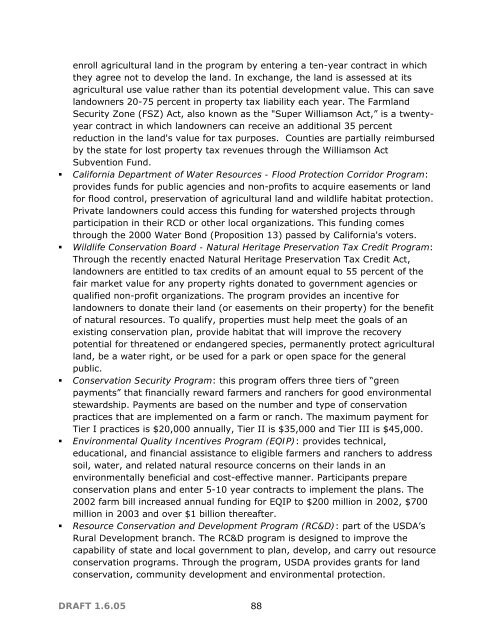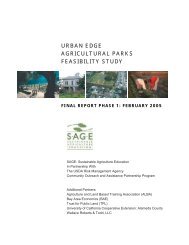A Feasibility Study for Urban Edge Agricultural Parks - SAGE
A Feasibility Study for Urban Edge Agricultural Parks - SAGE
A Feasibility Study for Urban Edge Agricultural Parks - SAGE
Create successful ePaper yourself
Turn your PDF publications into a flip-book with our unique Google optimized e-Paper software.
enroll agricultural land in the program by entering a ten-year contract in whichthey agree not to develop the land. In exchange, the land is assessed at itsagricultural use value rather than its potential development value. This can savelandowners 20-75 percent in property tax liability each year. The FarmlandSecurity Zone (FSZ) Act, also known as the "Super Williamson Act,” is a twentyyearcontract in which landowners can receive an additional 35 percentreduction in the land's value <strong>for</strong> tax purposes. Counties are partially reimbursedby the state <strong>for</strong> lost property tax revenues through the Williamson ActSubvention Fund.• Cali<strong>for</strong>nia Department of Water Resources - Flood Protection Corridor Program:provides funds <strong>for</strong> public agencies and non-profits to acquire easements or land<strong>for</strong> flood control, preservation of agricultural land and wildlife habitat protection.Private landowners could access this funding <strong>for</strong> watershed projects throughparticipation in their RCD or other local organizations. This funding comesthrough the 2000 Water Bond (Proposition 13) passed by Cali<strong>for</strong>nia's voters.• Wildlife Conservation Board - Natural Heritage Preservation Tax Credit Program:Through the recently enacted Natural Heritage Preservation Tax Credit Act,landowners are entitled to tax credits of an amount equal to 55 percent of thefair market value <strong>for</strong> any property rights donated to government agencies orqualified non-profit organizations. The program provides an incentive <strong>for</strong>landowners to donate their land (or easements on their property) <strong>for</strong> the benefitof natural resources. To qualify, properties must help meet the goals of anexisting conservation plan, provide habitat that will improve the recoverypotential <strong>for</strong> threatened or endangered species, permanently protect agriculturalland, be a water right, or be used <strong>for</strong> a park or open space <strong>for</strong> the generalpublic.• Conservation Security Program: this program offers three tiers of “greenpayments” that financially reward farmers and ranchers <strong>for</strong> good environmentalstewardship. Payments are based on the number and type of conservationpractices that are implemented on a farm or ranch. The maximum payment <strong>for</strong>Tier I practices is $20,000 annually, Tier II is $35,000 and Tier III is $45,000.• Environmental Quality Incentives Program (EQIP): provides technical,educational, and financial assistance to eligible farmers and ranchers to addresssoil, water, and related natural resource concerns on their lands in anenvironmentally beneficial and cost-effective manner. Participants prepareconservation plans and enter 5-10 year contracts to implement the plans. The2002 farm bill increased annual funding <strong>for</strong> EQIP to $200 million in 2002, $700million in 2003 and over $1 billion thereafter.• Resource Conservation and Development Program (RC&D): part of the USDA’sRural Development branch. The RC&D program is designed to improve thecapability of state and local government to plan, develop, and carry out resourceconservation programs. Through the program, USDA provides grants <strong>for</strong> landconservation, community development and environmental protection.DRAFT 1.6.05 88





